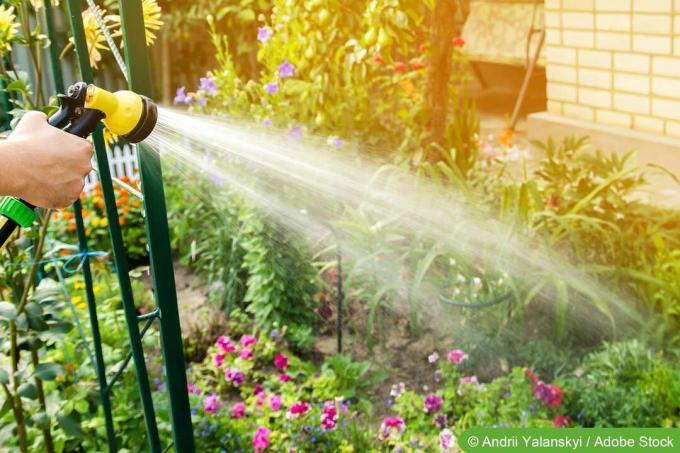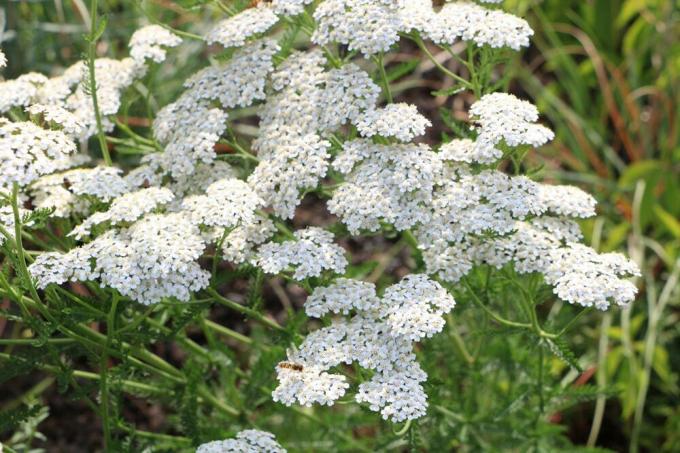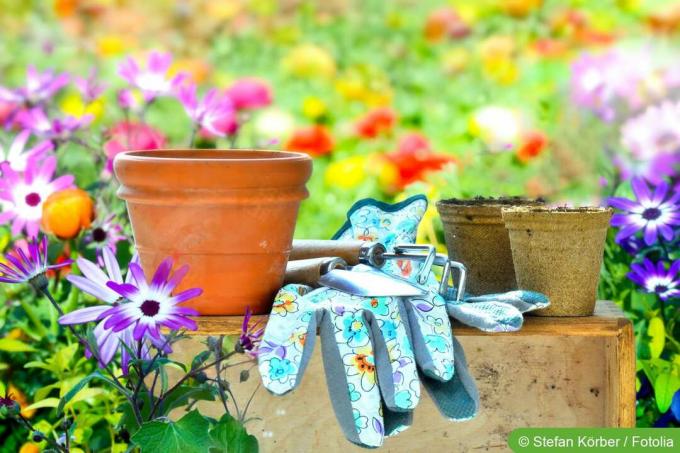

Table of contents
- Gardening in July
- More gardening tips for the month of June
- Fertilize, water, care
- Annual and biennial flowers
- ornamental shrubs and hedges
- fruit trees and shrubs
- Wine
- herbs and vegetables
- Tips for speed readers
July is the month of roses. Most roses now unfold in their perfect beauty. Also in perennial bed some are blooming now. Balcony flowers sway their dainty blossoms in the wind and most of the potted plants have finally decided to flower.
Gardening in July
- Perennials and other plants can be planted in the ground on overcast days or in the evening. Sufficient watering is now the top priority, the plants are very sensitive to drought. pot plants and other easily woody plants can now be easily propagated using sticks. Be sure to place the pots and bowls with the freshly cut sticks in a shady place.
- Most of the potted plants are now in full bloom and delight us with their colors and scents. On the terrace, however, you should make sure that not too many scents mix. This can lead to headaches or even nausea. A scented plant is enough for them terrace. The only exceptions are herbs. It can be a bit more of this. In order to prevent seed formation (unless it is expressly desired), you should also remove the withered flowers on potted plants.
- Roses are also very easy to propagate from cuttings. Especially dwarf, bedding and climbing roses gladly allow that. July is the best time for this. Stick the rose cuttings directly into the moistened soil in a shady place and ideally put an old, clean mason jar over them. They will root after a few weeks, but the rooted rose should stay in place for 1-2 years. It is important that they are supplied with sufficient and regular water.
- In July, tall perennials bloom more often in the garden. To protect them from twisting, they should be supported. The supports also prevent falling apart during heavy rains. Between the perennials you should now regularly chop the soil and remove weeds. Chopping loosens and aerates the soil. This means that water can reach the roots faster and more easily.
- July is the next fertilizer period for roses, herbs and perennials. Harsh consuming plants will now grow again fertilized. It is essential to ensure that the soil is moist when applying the fertilizer (preferably after watering). Lightly incorporate fertilizer into the soil. Due to the moisture, the nutrients dissolve faster and are available to the plants after a short time.
- In the fruit and vegetable garden is also Fertilize hip, trendy, popular. It is best to do the fertilizing together with the watering. July is also the harvest month for many types of fruit. Strawberries, raspberries, and some other early fruits can now be harvested. Any excess can be made into compote or jam. You can use berries to make delicious fruit foam for dessert. Leave to cool in the freezer and enjoy ice-cold.
More gardening tips for the month of June
July is usually quite sunny and warm, but can also be rainy. Regardless of the weather, there is always something to do in the garden. The lawn can now stand a little longer, but like all other plants, it must be well watered during dry periods. The fruit trees need a lot of attention, and the first preparations for overwintering the plants, as well as next year's flowering, can be made.
Fertilize, water, care
In July, the plants need care. It is dry, most of the plants produce fruit – not only does it have to be watered regularly and generously, but also fertilized. This applies to potted plants as well as plants in the open air. Beds are only raked and loosened very carefully so as not to damage the plants. However, floor care is still important so that the water does not evaporate so quickly and can be absorbed easily. Dry soil isn't just sealed quite well on the surface (so rainwater wouldn't come easy at all taken up, but flow over it), but also forms capillary tunnels, over which the water quite quickly evaporates.
Annual and biennial flowers
Next year's spring and summer flowering bulbs can be sown in July. This applies to pansies, columbines, forget-me-nots, foxgloves, carnations and mallows. Anyone who has already sown the plants in June (this is also possible) can prick out the young plants. The beds should be kept loose, well fertilized and watered regularly. This is good for seeds and young plants alike. Incidentally, you can propagate cuttings such as hydrangeas well in July. For this purpose, the plants should be healthy and strong and not blooming if possible. Make sure that the cuttings find the same, as optimal as possible, climate as the mother plant - this does not guarantee growth, but increases the chances of success.
ornamental shrubs and hedges
Many shrubs and hedges are slowly dying. You should remove the withered flowers so that the plants can develop new flowers instead of fruit. Fruits sap the plant's strength and thereby prevent many more flowers from being formed. This is especially true for reblooming roses. Hedges are always trimmed in July and the roses are fertilized for the last time.
Incidentally, perennials do not need much care in July. Faded flowers should be removed and tall perennials should be tied up if you haven't already. Cut hedges should be properly shaped in July, and don't forget to water the plants in the tub as well as outdoors really well. July is often quite dry.
fruit trees and shrubs
When it comes to fruit, there is a lot going on in July. Fruit trees have to be watered, which is always important, especially for young trees. The fruit trees receive their last fertilization in July, and of course they can be harvested. Currants, gooseberries, late strawberries, cherries and sour cherries, pears, raspberries and clear apples are now ripe. The fruit gets really heavy on the trees, and to keep the branches from breaking, consider putting up fruit tree supports. They give the heavily laden branches support, especially when one or two summer thunderstorms with strong gusts of wind shake the trees. If you are worried about your crops, you can place bird netting over the trees to protect the ripe fruit.
After the harvest, some fruit trees are pruned - this mainly affects sour cherries and apricots, which can be harvested in July. Apple, pear and plum can be grafted when the weather is cloudy. The young shoots of the kiwi are cut back in July so that the plants do not overgrow and put all their energy into growth.
Wine
The wine is far from ready for harvest, the grapes still need time. But stinging shoots keep growing, which can still be broken out in July. Stingy shoots have their purpose, they are formed by the plants in the same way as other shoots, they have all the organs like other shoots, but these are a bit smaller. It used to be said that stinging shoots must be removed. Today we know that this is not the case - stinging shoots are important and ensure that the grapes can really ripen well. They are actually only removed when they develop strong foliage on the grapes. That would bother you because it increases the risk of fungal infections. You should only remove stinging shoots if they are too leafy. Heavy foliage growth around the grapes should definitely be removed and this work falls in July. When doing this work, be careful not to damage the trunk or the grapes.
herbs and vegetables
Most herbs can be harvested in July. What you don't use fresh you can freeze or dry to stock up. Loosen the beds carefully so that the moisture in the soil is better retained and water can be absorbed more easily.
You can harvest the first potatoes in July, and some other types of vegetables such as carrots, radishes, onions, peas, beans and the like may also be ready to harvest.
But it can also be sown: carrots and Chinese cabbage, for example. Other vegetables such as zucchini, peppers, cucumbers and tomatoes may be partially ready to harvest. Water the plants regularly and plentifully, because they need a lot of water, especially in the last stage of fruit growth.
Tips for speed readers
- Water all plants regularly and generously, including the lawn.
- Fertilize potted and outdoor plants well.
- Rake and loosen soil in beds carefully but regularly.
- Sow spring and summer flowering bulbs for next year or prick out (if they were sown in June). Be sure to keep beds moist and loose, fertilize.
- Possibly propagate cuttings.
- Remove wilted flowers from perennials and tie on tall perennials.
- Cut hedges into shape.
- Water and fertilize fruit trees.
- Harvest ripe berries and fruit, set up fruit tree supports. Possibly spread bird nets.
- Cut sour cherries and apricots after harvest, cut back young kiwi shoots.
- Refine apples, pears and plums in cloudy weather.
- Remove heavy foliage from the wine.
- Harvest and process herbs or stock up.
- Harvest early potatoes and other vegetables.
- Sow carrots and Chinese cabbage.
- Water all the vegetables well, carefully rake the beds and keep the soil loose.
 garden editorial
garden editorial I write about everything that interests me in my garden.
Learn more about gardening tips

Are hostas poisonous? | All information for humans & animals
Hostas, also called sweetheart lilies, can be planted out in the garden or kept in a bucket. They are considered easy to care for and are ideal for "dark" locations. Also, they are non-toxic, making them safe to cultivate in homes with children and/or pets.

Is yarrow poisonous? | Beware of confusion
Yarrow is a widespread herbaceous plant. The plant is very common on roadsides and in gardens and can be attractive to both animals and children. But the plant is harmless or poisonous. Here is the answer.

Remove Virginia creeper: the best remedies against clinging roots
Wilder Wein is a real climbing artist. Over time, it conquers the whole house with its foliage. But trying to get it off the wall is tedious, time-consuming and not always successful. What really helps?

Poisonous and non-toxic plants for horses - Attention poisonous plants
The horse has made itself indispensable as a sports partner, and its evolutionary survival seems assured. The poisonous plants that a horse can encounter in everyday life are becoming more and more diverse, they can even get into the hay or concentrated feed. A little information is therefore absolutely necessary so that a horse can go through its days as safely as possible; the article gives an overview.

Gardening Tips for November - Gardening Calendar
In November it's time to make the garden, balcony and terrace winter-proof. Potted plants that are not hardy should now be cut back and put away. The last vegetables are harvested in the vegetable garden. And by the way, leaves are being swept diligently. What else should you think about? We summarize the most important things.

Gardening Tips for June - Gardening Calendar
June brings a lot of gardening with it, after the rather quiet May it can get quite exhausting. But the first fruits of the work can also be harvested: strawberries and some early berry bushes can be harvested. Of course, this also means that the ripening fruit must be protected from hungry birds.
